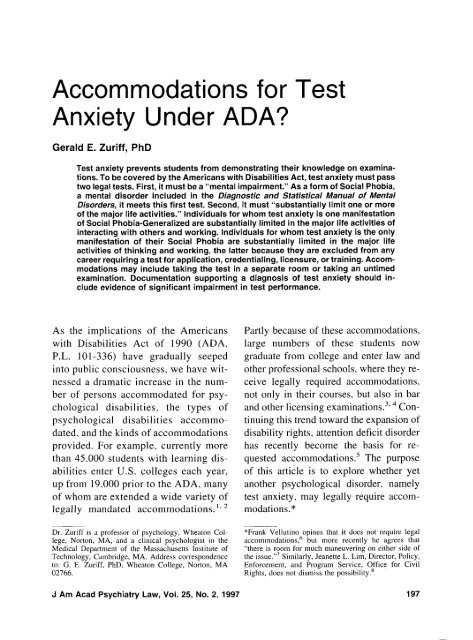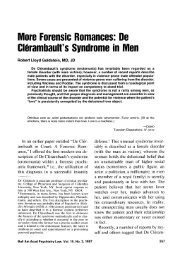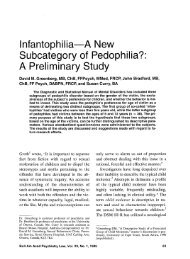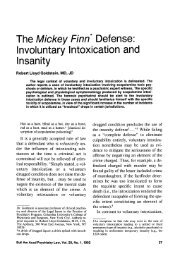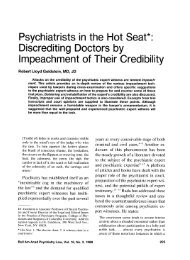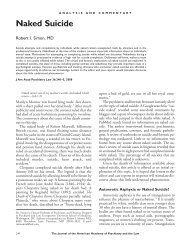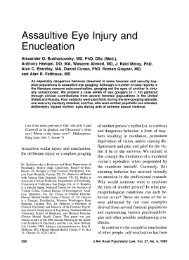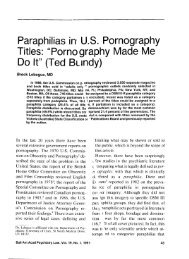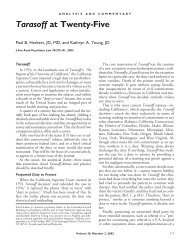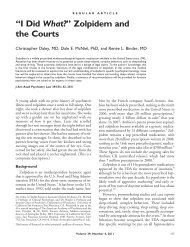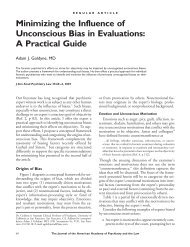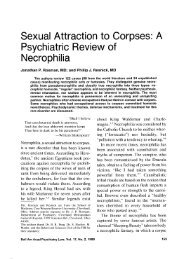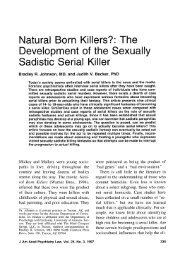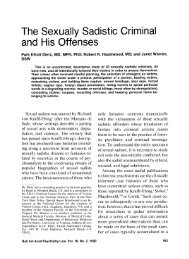Accommodations for Test Anxiety Under ADA?
Accommodations for Test Anxiety Under ADA?
Accommodations for Test Anxiety Under ADA?
You also want an ePaper? Increase the reach of your titles
YUMPU automatically turns print PDFs into web optimized ePapers that Google loves.
<strong>Accommodations</strong> <strong>for</strong> <strong>Test</strong><br />
<strong>Anxiety</strong> <strong>Under</strong> <strong>ADA</strong>?<br />
Gerald E. Zuriff, PhD<br />
<strong>Test</strong> anxiety prevents students from demonstrating their knowledge on examinations.<br />
To be covered by the Americans with Disabilities Act, test anxiety must pass<br />
two legal tests. First, it must be a "mental impairment." As a <strong>for</strong>m of Social Phobia,<br />
a mental disorder included in the Diagnostic and Statistical Manual of Mental<br />
Disorders, it meets this first test. Second, it must "substantially limit one or more<br />
of the major life activities." Individuals <strong>for</strong> whom test anxiety is one manifestation<br />
of Social Phobia-Generalized are substantially limited in the major life activities of<br />
interacting with others and working. Individuals <strong>for</strong> whom test anxiety is the only<br />
manifestation of their Social Phobia are substantially limited in the major life<br />
activities of thinking and working, the latter because they are excluded from any<br />
career requiring a test <strong>for</strong> application, credentialing, licensure, or training. <strong>Accommodations</strong><br />
may include taking the test in a separate room or taking an untimed<br />
examination. Documentation supporting a diagnosis of test anxiety should include<br />
evidence of significant impairment in test per<strong>for</strong>mance.<br />
As the implications of the Americans<br />
with Disabilities Act of 1990 (<strong>ADA</strong>,<br />
P.L. 101-336) have gradually seeped<br />
into public consciousness, we have witnessed<br />
a dramatic increase in the number<br />
of persons accommodated <strong>for</strong> psychological<br />
disabilities, the types of<br />
psychological disabilities accommodated,<br />
and the kinds of accommodations<br />
provided. For example, currently more<br />
than 45.000 students with learning disabilities<br />
enter U.S. colleges each year,<br />
up from 19,000 prior to the <strong>ADA</strong>, many<br />
of whom are extended a wide variety of<br />
legally mandated accon~rnodations.~~<br />
Partly because of these accommodations,<br />
large numbers of these students now<br />
graduate from college and enter law and<br />
other professional schools, where they receive<br />
legally required accommodations,<br />
not only in their courses, but also in bar<br />
and other licensing examination^.^, Continuing<br />
this trend toward the expansion of<br />
disability rights, attention deficit disorder<br />
has recently become the basis <strong>for</strong> requested<br />
accommodation^.^ The purpose<br />
of this article is to explore whether yet<br />
another psychological disorder, namely<br />
test anxiety, may legally require accommodations.*<br />
Dr. Zuriff is a professor of psychology, Wheaton College,<br />
Norton. MA, and a clinical psychologist in the<br />
Medical Department of the Massachusetts Institute of<br />
Technology, Cambridge, MA. Address correspondence<br />
to: G. E. Zuriff, PhD, Wheaton College, Norton, MA<br />
-<br />
*Frank Vellutino opines that it does not require legal<br />
accom~nodations,~ but more recently he agrees that<br />
"there is room <strong>for</strong> much maneuvering on either side of<br />
the issue."' Similarly, Jeanette L. Lim, Director, Policy,<br />
En<strong>for</strong>cement, and Program Service, Office <strong>for</strong> Civil<br />
Rights, does not dismiss the possibility.R<br />
J Am Acad Psychiatry Law, Vol. 25, No. 2, 1997 197
Zuriff<br />
Nature of <strong>Test</strong> <strong>Anxiety</strong><br />
Symptoms <strong>Test</strong> anxiety9 consists of<br />
several components occurring regularly<br />
in reaction to a testing situation. First and<br />
most troubling to the person is a component<br />
of subjective distress. Persons with<br />
test anxiety experience intense fear or<br />
apprehension, sometimes bordering on<br />
terror. They may feel dizziness, tension,<br />
stomach discom<strong>for</strong>t, or fear that they are<br />
about to faint. A second prominent component<br />
consists of physical symptoms<br />
such as trembling, sweating, changes in<br />
heart rate and breathing, clammy hands,<br />
voice tremor, and muscular tension.<br />
These symptoms are usually accompanied<br />
by distracting, intrusive, negative<br />
thoughts such as "I cannot answer this<br />
question," "I am going to fail this<br />
course," or "My life is a failure." Finally,<br />
there is a cognitive component in which<br />
the person's mind "goes blank," familiar<br />
questions seem unrecognizable, and concentration<br />
is very difficult. These components<br />
interact in every possible permutation<br />
with thoughts and physical<br />
symptoms increasing subjective anxiety<br />
and vice versa, resulting in severe cognitive<br />
impairment and poor test per<strong>for</strong>mance.<br />
<strong>Test</strong> anxiety, thus, can prevent<br />
test takers from demonstrating what they<br />
know.<br />
Treatment <strong>Test</strong> anxiety can be<br />
treated either psychopharmacologically<br />
or with psychotherapy. Among the drugs,<br />
beta blockers (e.g., Inderal) can lessen<br />
many of the physical symptoms, and antianxiety<br />
benzodiazepines (e.g., Xanax)<br />
can reduce the anxiety. One disadvantage<br />
of these medications is that they may<br />
impair cognitive functioning and may<br />
there<strong>for</strong>e be contraindicated in a testing<br />
situation. Also, they may be unsafe <strong>for</strong><br />
people with certain medical conditions.<br />
Effective psychotherapy may consist of<br />
behavior therapy, cognitive therapy, or a<br />
combination of the two. In these therapies,<br />
clients learn ways to reduce their<br />
symptoms. They are desensitized to the<br />
testing situation and are taught methods<br />
to control the negative thoughts giving<br />
rise to the anxiety, as well as techniques<br />
to relax the body to prevent the physical<br />
symptoms. Although highly effective,<br />
these treatments do not work <strong>for</strong> everyone.<br />
For those who cannot be successfully<br />
treated, modifications of the testing situation<br />
can be beneficial. Many find that<br />
taking the examination alone in a quiet<br />
room alleviates the anxiety. Not seeing<br />
others feverishly working and finishing<br />
early reduces their symptoms and af<strong>for</strong>ds<br />
them the privacy to use their own personal<br />
methods of calming themselves<br />
down.<br />
For others, a quiet room may not be<br />
sufficient, and they may need a change in<br />
the timing conditions of the exam. The<br />
passage of time is probably the most anxiety-provoking<br />
aspect of the testing situation<br />
<strong>for</strong> test-anxious examinees. As their<br />
symptoms make them unable to work, the<br />
approach of the time deadline increases<br />
their anxiety, and symptoms tend to escalate<br />
with the passage of time. There<strong>for</strong>e,<br />
an untimed (or extended time) exam often<br />
alleviates symptoms by allowing the test<br />
taker to calm down without worry about<br />
the loss of time. Often the paradoxical<br />
result of an untimed exam is that the<br />
198 J Am Acad Psychiatry Law, Vol. 25, No. 2, 1997
<strong>Accommodations</strong> <strong>for</strong> <strong>Test</strong> <strong>Anxiety</strong> <strong>Under</strong> <strong>ADA</strong>?<br />
accommodated examinees do not, in fact,<br />
use much of the extra time.<br />
For some people, test anxiety is a<br />
chronic, life-long affliction. They manage<br />
to get through school by adopting various<br />
strategies. For example, they learn to select<br />
courses in which the grade is determined<br />
primarily by papers, homework,<br />
and classroom discussion. Or they become<br />
adept at convincing teachers to<br />
modify the testing situation <strong>for</strong> them.<br />
When these strategies fail, they must<br />
learn to cope with the disappointments of<br />
grades that do not accurately reflect their<br />
knowledge.<br />
For others, test anxiety may develop<br />
relatively late in their academic careers.<br />
A typical scenario may look like this: a<br />
successful student unexpectedly does<br />
poorly on an important exam. Memories<br />
of this failure cause the student to feel<br />
more nervous on the next exam, thereby<br />
further impairing per<strong>for</strong>mance. On the<br />
third exam, there are now two previous<br />
failures to evoke anxiety, and so on. A<br />
downward spiral of this sort can rapidly<br />
develop into serious test anxiety when the<br />
symptoms occur intensely and consistently<br />
to most testing situations.<br />
As Distinct from Normal Nervousness<br />
How does test anxiety differ from the<br />
nervousness all of us feel while taking an<br />
exam? Do we all have a psychiatric disorder?<br />
This kind of question arises with<br />
regard to many psychiatric diagnoses.<br />
Frequently, the critical symptoms identifying<br />
a psychiatric disorder include normal<br />
traits such as indecision, sadness, or<br />
worry. However, the traits do not reach<br />
the criterion of a mental disorder unless<br />
they are what is termed "clinically signif-<br />
icant."" Clinical significance is determined<br />
in two ways. One measure is the<br />
degree of impairment in functioning.<br />
Thus, if a student becomes anxious on an<br />
exam, but per<strong>for</strong>mance is not significantly<br />
below what would be expected<br />
based on the student's knowledge or skill,<br />
then the anxiety is not clinically significant<br />
on this dimension.<br />
The second measure is the degree of<br />
distress experienced. Thus, a student may<br />
become anxious during an exam, but the<br />
degree of distress may be well within the<br />
range experienced by most students in a<br />
testing situation and there<strong>for</strong>e not clinically<br />
significant. To assess the degree of<br />
distress, several psychological tests have<br />
been developed. Two of the most important<br />
are the Reactions to ~ests" and the<br />
<strong>Test</strong> Attitude Inventory.12 In both of these<br />
tests, students are presented with statements<br />
describing typical symptoms of test<br />
anxiety (e.g., "I freeze up when I think<br />
about an upcoming test"; "During tests I<br />
find myself thinking about the consequences<br />
of failing") and they must indicate<br />
whether the statement is true of them<br />
"almost always." "often," "sometimes,"<br />
or "almost never." Because these tests<br />
have been administered to large numbers<br />
of students, it is possible to know when a<br />
person's score is significantly above the<br />
average.<br />
Nondiscrimination on the Basis<br />
of Disability<br />
<strong>ADA</strong> The <strong>ADA</strong> is modeled after<br />
Section 504 of the Rehabilitation Act of<br />
1973, which prohibits discrimination<br />
against otherwise qualified persons with<br />
disabilities in any program receiving fed-<br />
J Am Acad Psychiatry Law, Vol. 25, No. 2, 1997 199
Zuriff<br />
era1 funds. Because of its longer history,<br />
most of the case law regarding the legal<br />
definition of "disability" comes from<br />
court decisions based on Section 504 and<br />
much is applicable to <strong>ADA</strong> as well.+<br />
However, <strong>ADA</strong> significantly expanded<br />
the civil rights of disabled persons to areas<br />
not encompassed by Section 504.<br />
Title I of the <strong>ADA</strong> prohibits discrimination<br />
in employment <strong>for</strong> all employers<br />
with 15 or more employees. It is relevant<br />
to the present discussion if an employer<br />
requires a written or oral examination <strong>for</strong><br />
the purposes of hiring, promotion, or periodic<br />
evaluation. Title I1 covers public<br />
services, including state and local governments<br />
not receiving federal funds, and is<br />
relevant to tests administered by public<br />
schools, state universities, colleges and<br />
universities that receive federal funds,<br />
and public agencies. Title I11 applies to<br />
public accommodations provided by private<br />
entities and covers tests administered<br />
by private schools, private certification<br />
boards, as well as private institutions such<br />
as the Educational <strong>Test</strong>ing Service, which<br />
prepares admissions tests <strong>for</strong> college and<br />
graduate schools. Licensing boards, such<br />
as state bar examination boards, are covered<br />
by both Titles I1 and I11 because they<br />
are considered instrumentalities of the<br />
state.I3 Title I11 addresses examinations<br />
in the greatest detail (28 C.F.R. §36.309),<br />
and the Department of Justice considers<br />
this section as a useful guide to examinations<br />
that fall under Title I1 as well.I4<br />
Mental Impairment Is test anxiety<br />
covered by <strong>ADA</strong>? An affirmative answer<br />
h he Rehabilitation Act Amendments of 1992 further<br />
brought the two acts into convergence.<br />
to this question must overcome several<br />
legal hurdles. First, unlike learning disabilities,<br />
test anxiety is not explicitly<br />
mentioned in the <strong>ADA</strong>, its regulations.<br />
the Equal Employment Opportunity<br />
Commission (EEOC) interpretive guide,<br />
or the Department of Justice (DOJ) analysis.<br />
Thus, the first hurdle is to find an<br />
<strong>ADA</strong> category in which test anxiety may<br />
possibly fit. All three titles (29 C.F.R.<br />
§1630.2(g) and (h); 28 C.F.R. 935.104;<br />
28 C.F.R. §36.104), as well as Section<br />
504 of the Rehabilitation Act of 1973 (34<br />
C.F.R. 5 104.3), define "disability" as "a<br />
physical or mental impairment that substantially<br />
limits one or more of the major<br />
life activities. . ." Thus, the most likely<br />
category to cover test anxiety is "mental<br />
impairment."<br />
"Mental impairment," in turn, is defined<br />
as "any mental or psychological<br />
disorder, such as mental retardation, organic<br />
brain syndrome, emotional or mental<br />
illness, and specific learning disabilities."<br />
Is test anxiety a "mental or<br />
psychological disorder" or an "emotional<br />
or mental illness"? The legislative history<br />
of <strong>ADA</strong> as well as major court cases<br />
indicate that the authoritative guide to<br />
defining these terms is the Diagnostic and<br />
Statistical Manual of Mental Disorders<br />
(DSM) published by the American Psychiatric<br />
Association and now in its fourth<br />
edition. 1 0 IS- I7<br />
This tome lists several<br />
hundred psychiatric disorders along with<br />
their diagnostic criteria and code num-<br />
bers.<br />
Social Phobia The next hurdle to<br />
overcome is that test anxiety does not<br />
appear in the DSM. Thus, if it is to count<br />
as a disability under <strong>ADA</strong>, it must be<br />
200 J Am Acad Psychiatry Law, Vol. 25, No. 2, 1997
<strong>Accommodations</strong> <strong>for</strong> <strong>Test</strong> <strong>Anxiety</strong> <strong>Under</strong> <strong>ADA</strong>?<br />
included under one of the DSM diagnostic<br />
categories. The most likely candidate<br />
<strong>for</strong> this is Social Phobia (code 300.23), a<br />
psychiatric disorder in which there is a<br />
marked and persistent fear of one or more<br />
social or per<strong>for</strong>mance situations in which<br />
embarrassment may occur (p. 411). People<br />
with Social Phobia regularly experience<br />
clinically significant anxiety in one<br />
or more situations such as public speaking,<br />
participating in small groups, dating,<br />
attending parties, and speaking to authority<br />
figures.18. l9 Some may feel anxious in<br />
nearly all these social situations and are<br />
diagnosed with Social Phobia, Generalized.<br />
Others may regularly fear only a<br />
single per<strong>for</strong>mance situation. such as<br />
public speaking or test taking. Thus, test<br />
anxiety resulting from a fear of being<br />
negatively judged by others is properly<br />
diagnosed as Social Phobia, either generalized<br />
or not, and seems to meet both the<br />
Section 504 and the <strong>ADA</strong> criterion <strong>for</strong> a<br />
mental impairment.<br />
Major Life Activity<br />
The final hurdle<br />
to coverage as a disability under <strong>ADA</strong> is<br />
whether test anxiety "substantially limits<br />
one or more of the major life activities.<br />
. ." Examples of major life activities<br />
under all three titles of <strong>ADA</strong>, as well as<br />
under Section 504, include: caring <strong>for</strong><br />
oneself, per<strong>for</strong>ming manual tasks, walking,<br />
seeing, hearing, speaking, breathing,<br />
learning, and working. However, this list<br />
is intended to be representative rather<br />
than exhaustive. Other activities having a<br />
similar effect on a person's functioning<br />
may also qualify as major life activities.<br />
In fact, Section 902 (paragraph 902.3),<br />
added to the EEOC Compliance Manual<br />
in March 1995.*' states that "mental and<br />
emotional processes such as thinking.<br />
concentrating, and interacting with others<br />
are examples of major life activities."<br />
Similarly. paragraph 902.8 of this manual<br />
illustrates a major life activity with the<br />
example of a bank teller who has a mild<br />
<strong>for</strong>m of clinically diagnosed depression<br />
and whose employer assumes she cannot<br />
work well with customers and other<br />
members of the public. Hence, if a person's<br />
test anxiety is only one symptom<br />
within a broader syndrome covering a<br />
wide variety of social situations (i.e., Social<br />
Phobia, Generalized), then a strong<br />
case can be made that the disorder substantially<br />
limits the major life activity of<br />
irzteractirlg with others. In fact, significant<br />
interference with the person's social<br />
interactions is one of the criteria <strong>for</strong> the<br />
diagnosis.<br />
Additionally, it can be argued that Social<br />
Phobia, Generalized, also substantially<br />
limits the major life activity of<br />
working.* Anxieties arising from a generalized<br />
social phobia can seriously impair<br />
per<strong>for</strong>mance during job interviews, group<br />
presentations, consulting with managers,<br />
talking to customers, and attending conferences.<br />
Anyone impaired in these ways<br />
will be severely limited in the ability to be<br />
hired and to work in a broad range of jobs<br />
in which effective social interaction is<br />
critical. Thus, Social Phobia, Generalized,<br />
along with its symptom of test anxiety,<br />
appears to be covered by both Section<br />
504 and the <strong>ADA</strong>.^'<br />
What if the test anxiety is the only<br />
he EEOC Compliance Manual makes it clear that the<br />
major life activity of working should be considered only<br />
when it cannot be shown that the other, more basic,<br />
major life activities are not substantially limited.20<br />
J Am Acad Psychiatry Law, Vol. 25, No. 2, 1997 201
Zuriff<br />
symptom of the Social Phobia and the<br />
person is not impaired in other social<br />
situations? Here, it is more difficult to<br />
argue that the disorder substantially limits<br />
a major life activity. Nevertheless, two<br />
avenues of approach are available. First,<br />
one might argue that test anxiety substantially<br />
limits the major life activity of<br />
thinking. During an episode of test anxiety,<br />
the examinee's cognitive faculties are<br />
compromised: concentration, memory,<br />
reasoning, and expression are impaired<br />
relative to other examinees. The objection<br />
might be raised that the test-anxious person's<br />
thinking is impaired only during the<br />
exam, but otherwise it is normal. In response<br />
to this objection, it should be<br />
noted that individuals with serious mental<br />
disorders such as major depression and<br />
schizophrenia (recognized by the courts<br />
as protected by <strong>ADA</strong>) do not exhibit their<br />
symptoms continuously. For example, the<br />
schizophrenic employee whose work is<br />
substantially limited by hallucinations<br />
and emotional outbursts may experience<br />
those symptoms only a few times in the<br />
course of the work week and only under<br />
certain stressful conditions. Similarly,<br />
test-anxious individuals may think perfectly<br />
well most of the time but find their<br />
thinking substantially limited during the<br />
critical duration of an examination. Indeed,<br />
it is this impairment in cognitive<br />
function that is the very basis <strong>for</strong> the<br />
requested accommodation.<br />
The second and more questionable argument<br />
<strong>for</strong> substantial limitation of a major<br />
life activity is that the test-anxious<br />
individual is effectively excluded from<br />
any career requiring a test <strong>for</strong> application,<br />
credentialing, licensure, or training<br />
courses. For example, test anxiety can<br />
prevent an individual from entering the<br />
professions of law, psychology, and engineering,<br />
each of which requires the<br />
passing of an examination <strong>for</strong> licensure.<br />
Similarly, if test anxiety precludes someone<br />
from graduating from college because<br />
of anxiety-induced poor per<strong>for</strong>mance<br />
on college entrance exams or<br />
college course exams, that person's career<br />
prospects are severely curtailed.<br />
Nevertheless, given the difficulty in convincing<br />
the courts that mental disabilities<br />
substantially limit the major life activity<br />
of working, this line of argument will<br />
face an uphill battle.<br />
An examination of court cases regarding<br />
a closely related disorder, Simple<br />
Phobia (code 300.29), is instructive. In<br />
contrast to Social Phobia, a Simple Phobia<br />
involves a fear of a specific stimulus<br />
object or situation rather than a fear of<br />
embarrassment. In Freyer v. Kinetic Concepts,<br />
1988 WL 96033, 122 Lab Cas<br />
(CCH) paragraph 56, 957 (S.D.N.Y.<br />
1988), the court refused to recognize an<br />
employee's undiagnosed and undocumented<br />
fear of flying as a handicap under<br />
Section 504. In Forrisi v. Bowen, 794<br />
F.2d 931, 934 (4th Cir 1986), a utility<br />
repairman had been fired because his fear<br />
of heights (acrophobia) made him unable<br />
to per<strong>for</strong>m his job, which often involved<br />
climbing up a ladder. He argued that he<br />
should be protected by Section 505 of the<br />
Rehabilitation Act because he was regarded<br />
as a handicapped individual by his<br />
employer. The court found that although<br />
his phobia excluded him from his particular<br />
job, it did not significantly restrict his<br />
ability to per<strong>for</strong>m either a class of jobs or<br />
202 J Am Acad Psychiatry Law, Vol. 25, No. 2, 1997
<strong>Accommodations</strong> <strong>for</strong> <strong>Test</strong> <strong>Anxiety</strong> <strong>Under</strong> <strong>ADA</strong>?<br />
a broad range of jobs in various classes.<br />
Accordingly, he was not regarded as substantially<br />
limited in the major life activity<br />
of working.<br />
Although this latter case may suggest<br />
that test anxiety will encounter a similar<br />
judicial fate, important distinctions can be<br />
drawn between the two. Forrisi's acrophobia<br />
did not preclude the possibility of<br />
his worlng as a utility repairman in jobs<br />
not requiring climbing to heights, and he<br />
was thus not limited in a class of jobs (as<br />
required by both the <strong>ADA</strong> and the Rehabilitation<br />
Act) but only in his specific<br />
one. In contrast, test anxiety can preclude<br />
an individual from a class of professions<br />
and jobs that require examinations <strong>for</strong><br />
application, credentialing, licensure, or<br />
training courses.<br />
Reasonable <strong>Accommodations</strong> and<br />
Modifications Assuming that test anxiety<br />
has surmounted all of the legal hurdles<br />
described above, the <strong>ADA</strong> requires<br />
that the examiner make "reasonable accommodations"<br />
when covered by Title I<br />
(29 C.F.R. 31630.9, 1630.10, 1630.1 l),<br />
or "reasonable modifications" under Titles<br />
I1 and I11 (28 C.F.R. 335.130(b)(7);<br />
28 C.F.R. $36.302) (see also Section 504<br />
of the Rehabilitation Act, 34 C.F.R.<br />
$104.12. 104.13, 104.43, 104.44). In particular.<br />
an examiner, be it an employer,<br />
college, or testing service, may not use a<br />
test the results of which tend to screen out<br />
an individual with a disability or to not<br />
accurately reflect a disabled person's<br />
skills, aptitude, or knowledge. There<strong>for</strong>e,<br />
examiners must provide accommodations<br />
or modifications <strong>for</strong> students with test<br />
anxiety because this disability prevents<br />
them from accurately demonstrating their<br />
abilities and knowledge on a test.<br />
Any examiner who wishes to deny a<br />
requested accommodation or modification<br />
<strong>for</strong> test anxiety must show that the<br />
request is not reasonable. <strong>Under</strong> Title I,<br />
an accommodation is not reasonable<br />
if it imposes an "undue hardship"<br />
on the business (29 C.F.R. 31630.9,<br />
1630.15(d)), and under Title I11 if it imposes<br />
an "undue burden" (28 C.F.R.<br />
336.303, 36.309(~)(3)) on the private entity."<br />
At present we have no good estimates<br />
of the number of persons with test<br />
anxiety. The incidence of social phobia is<br />
estimated to be about five to seven percent<br />
of the population, and not all of these<br />
experience test anxiety. Among those<br />
who do, some have been successfully<br />
treated. In any event, it is safe to say that<br />
the number needing to be accommodated,<br />
under the criteria described below, will be<br />
far fewer than the number of examinees<br />
with learning disabilities who are now<br />
being accommodated. Hence it is unlikely<br />
that accommodations <strong>for</strong> test anxiety will<br />
impose an undue hardship or burden on<br />
examiners.<br />
A second argument against the reasonableness<br />
of a request <strong>for</strong> untimed (or extended<br />
time) exams is that they undermine<br />
the purpose of the examination. If<br />
one of the goals of an exam is to see how<br />
well the examinee answers under time<br />
pressure. then an unpressured exam defeats<br />
that goal. Neither Section 504 nor<br />
Iln the Wynne v TI&^ Univ Sch of Med case discussed<br />
below, the court concludes that under Section 504, feasibility<br />
and cost may be taken into consideration by an<br />
academic institution in deciding whether a modification<br />
to an exam would result in a lowering of academic<br />
standards or requiring substantial program alteration.<br />
J Am Acad Psychiatry Law, Vol. 25, No. 2, 1997 203
Zuriff<br />
the <strong>ADA</strong> requires that an exam be<br />
changed such that it no longer measures<br />
what it is designed to measure (34 C.F.R.<br />
3104.13, 5104.44(c); 29C.F.R. $1630.11;<br />
28 C.F.R. analysis of 35.130; 28 C.F.R.<br />
336.309(b)(i)), as long as the examiner<br />
can justify the use of the exam in the first<br />
place. <strong>Under</strong> Title I, the examiner has to<br />
show that the test is job related, consistent<br />
with business necessity. and its purposes<br />
cannot be accomplished with a reasonable<br />
accommodation (29 C.F.R. 3 1630.10,<br />
1630.15(b); see also Section 504, 34<br />
C.F.R. Q: 104.13). <strong>Under</strong> Titles I1 and 111,<br />
the examiner must show that changing the<br />
exam as requested would fundamentally<br />
alter the nature of the service, program, or<br />
activity (28 C.F.R. §35.130(b)(7); 28<br />
C.F.R. §36.302(a)).<br />
An example of how this works can be<br />
found in Wyizize I?. Tufts Utziv. Sch. of<br />
Med., 932 F.2d 19 (1st Cis 1991) (en<br />
barzc). Wynne, a medical student with<br />
dyslexia, requested an examination <strong>for</strong>mat<br />
other than written multiple choice.<br />
The court found against him, explaining<br />
that under Section 504, if a school comes<br />
to a rationally justifiable conclusion that<br />
available alternatives would result either<br />
in the lowering of academic standards or<br />
requiring substantial program alteration,<br />
then the school is not legally required to<br />
acconlmodate the disability. The medical<br />
school had argued that there was no feasible<br />
way to alter the exam and still ensure<br />
that its medical students had acquired<br />
the necessary knowledge and<br />
skills. Agreeing with Tufts University,<br />
the court judged that modifying medical<br />
school exams would devalue the school's<br />
end product, namely. well-trained and<br />
qualified doctors.<br />
Thus, an examiner might argue that<br />
allowing some examinees to take an untimed<br />
exam will result in a lowering of<br />
standards and a substantial alteration of<br />
the program, or in the case of employment.<br />
that it is inconsistent with business<br />
necessity. This issue has already been<br />
amply and expertly discussed by a number<br />
of writers with regard to accommodations<br />
<strong>for</strong> learning-disabled examinee~,'~~"<br />
and their debate will not be<br />
repeated here. Nevertheless. one important<br />
distinction between test anxiety and<br />
learning disabilities needs to be mentioned<br />
in relation to the issue of standards.<br />
In theory, the rationale behind additional<br />
time <strong>for</strong> learning-disabled<br />
examinees is that they process in<strong>for</strong>mation<br />
more slowly than others, and extra<br />
time simply compensates <strong>for</strong> this discrepancy.<br />
Given extra time, learning-disabled<br />
examinees are on a par with the others<br />
and are, there<strong>for</strong>e, under the same time<br />
pressures. With test-anxious examinees.<br />
however, the circumstances are different.<br />
If extra time successfully reduces the anxiety<br />
to normal levels. then the result is an<br />
unimpaired examinee with extra time.<br />
Whether additional time is an advantage<br />
is a matter of debate.'7 With respect<br />
to the Multistate Bar Examination, <strong>for</strong><br />
example, some writers have cited data<br />
indicating that additional time bestows no<br />
benefits while others have found the opposite.28<br />
For the bar examination essay<br />
questions, however, the criterion <strong>for</strong> an<br />
adequate answer often takes into account<br />
the time limits.'" One solution to this<br />
problem is to measure the actual time<br />
204 J Am Acad Psychiatry Law, Vol. 25, No. 2, 1997
<strong>Accommodations</strong> <strong>for</strong> <strong>Test</strong> <strong>Anxiety</strong> <strong>Under</strong> <strong>ADA</strong>?<br />
taken by an accommodated test-anxious<br />
examinee and grade the essays accordingly.<br />
Criteria <strong>for</strong> Granting <strong>Accommodations</strong><br />
In granting accommodations <strong>for</strong><br />
test anxiety, examiners should be vigilant<br />
about potential abuses. Judgments about<br />
clinical significance are often subjective,<br />
and clinicians can differ widely. Accordingly,<br />
examiners should insist that clinicians<br />
who diagnose the disorder provide<br />
evidence of clinical significance, including<br />
perhaps scores on psychological tests.<br />
Of course, people can be dishonest both<br />
to their diagnosing clinician and on the<br />
psychological tests, and this dishonesty<br />
will be difficult to uncover.<br />
The most important criterion of clinical<br />
significance <strong>for</strong> the purpose of accommodation<br />
is the degree to which test anxiety<br />
impairs per<strong>for</strong>mance. A student whose<br />
knowledge and skills warrant a grade of<br />
A- but who gets only a B+ on exams<br />
because of anxiety is not clinically impaired<br />
and may not deserve accommodations<br />
despite the subjective distress. On<br />
the other hand, if that same student manages<br />
only Cs and Ds on exams, then the<br />
impairment is significant, the test scores<br />
clearly do not reflect the student's knowledge.<br />
and accommodations are in order.<br />
There<strong>for</strong>e, examiners should insist on evidence<br />
of discrepancies between test<br />
grades and other measures of what the<br />
student has learned. The latter can be<br />
obtained from grades on homework, papers,<br />
projects, classroom discussions. and<br />
the professor's or a teaching assistant's<br />
impressions based on evidence such as<br />
conversations with the student or a review<br />
of the exam after a poor per<strong>for</strong>mance.<br />
Conclusion<br />
<strong>Test</strong> anxiety can prevent examinees<br />
from demonstrating their knowledge and<br />
skills, and <strong>for</strong> them the test ceases to be a<br />
valid assessment instrument. For this reason<br />
alone. testers should want to accommodate<br />
test-anxious examinees and restore<br />
the test to its intended function.<br />
Such accommodations also help examiners<br />
avoid unnecessary litigation since, as I<br />
have tried to show, a good case can be<br />
made that test anxiety is covered by<br />
<strong>ADA</strong>, especially when it is a component<br />
of Social Phobia, Generalized.<br />
At the same time. examiners will want<br />
to protect the integrity and fairness of the<br />
test. Criteria <strong>for</strong> adequate documentation<br />
supporting a diagnosis of test anxiety<br />
should be made explicit. I have suggested<br />
that an important criterion should be evidence<br />
that the test anxiety significantly<br />
impairs per<strong>for</strong>mance as compared with<br />
assessments from non-test situations.<br />
When a diagnosis has been established,<br />
examiners should grant the minimum accommodation<br />
necessary to enable the examinees<br />
to operate within the normal<br />
range of anxiety. Often a separate, quiet<br />
room is all that is needed. If, however. an<br />
untimed examination is necessary. then<br />
examiners should keep a record of the<br />
time actually used and take that into consideration<br />
in grading the exam. With sufficient<br />
<strong>for</strong>esight and planning, solutions<br />
can be devised that will optimize validity<br />
<strong>for</strong> the test and fairness <strong>for</strong> all examinees.<br />
References<br />
I. Zuriff GE: Learning disabilities in the academy:<br />
a professor's guide. Acad Quest 10:53-<br />
65, Winter 1996-97<br />
J Am Acad Psychiatry Law, Vol. 25, No. 2, 1997 205
Zuriff<br />
2. Ragosta M: <strong>Test</strong>ing bar applicants with learning<br />
disabilities. 60 Bar Examiner No. 1, at 11<br />
(February 199 1)<br />
3. Overton G: Accommodation of disabled persons.<br />
60 Bar Examiner No. 1, at 6 (February<br />
1991)<br />
4. Smith J: NCBE guidelines <strong>for</strong> testing disabled<br />
applicants. 60 Bar Examiner No. 1, at 28<br />
(February 1991)<br />
5. Ranseen J, Campbell D: Adult attention deficit<br />
disorder: current concepts and controversies.<br />
65 Bar Examiner No. 1 at 49 (February<br />
1996)<br />
6. Vellutino F: Documenting the existence of<br />
"dyslexia." 63 Bar Examiner No. 4, at 13<br />
(November 1994)<br />
7. Vellutino F, personal communication, March<br />
14, 1995<br />
8. Lim JJ, personal communication, June 21,<br />
1994<br />
9. International Society <strong>for</strong> <strong>Test</strong> <strong>Anxiety</strong> Research:<br />
Advances in <strong>Test</strong> <strong>Anxiety</strong> Research<br />
(vols 1-7). Edited by Van der Ploeg et nl.<br />
Amsterdam: Swets and Zeitlinger, 198 1- 1992<br />
10. American Psychiatric Association: Diagnostic<br />
and Statistical Manual of Mental Disorders<br />
(ed 4). Washington, DC: APA, 1994, p 7<br />
1 1. Sarason I: Stress, anxiety, and cognitive interference:<br />
reactions to tests. J Pers Soc Psychol<br />
46:929-38, 1984<br />
12. Spielberger C: <strong>Test</strong> Attitude Inventory. Palo<br />
Alto, CA: Consulting Psychologists Press,<br />
1977<br />
13. Morrissey FP: The Americans with Disabilities<br />
Act: the disabling of the bar examination<br />
process? 62 Bar Examiner No. 2, at 9 (May<br />
1993), p 13<br />
14. Ibid.<br />
15. APA, supra note 10<br />
16. Paul F Mickey, Maryelena Pardo: Dealing<br />
with mental disabilities under the <strong>ADA</strong>. 9<br />
Labor Lawyer 536 at 531, n 18 (1993)<br />
17. U.S. Congress, Office of Technology Assessment:<br />
Psychiatric Disabilities, Employment,<br />
and the Americans with Disabilities Act.<br />
Washington, DC: U.S. Government Printing<br />
Office, March 1994, p. 45<br />
18. Marshall J: Social Phobia: From Shyness to<br />
Stage Fright. New York: Basic, 1994<br />
19. Stein MB: How shy is too shy? Lancet 347:<br />
1131-2, 1996<br />
20. Equal Employment Opportunity Commission:<br />
Compliance Manual (vol 2, 5 902). Washington,<br />
DC: EEOC, 1995<br />
21. See John M Casey: From agoraphobia to xenophobia:<br />
phobias and other anxiety disorders<br />
under the Americans with Disabilities Act. 17<br />
U Puget Sound L Rev 381 (1994)<br />
22. Smith, supra note 4<br />
23. Ragosta, supra note 2<br />
24. Mehrens W, Millman J, Sackett P: <strong>Accommodations</strong><br />
<strong>for</strong> candidates with disabilities. 63 Bar<br />
Examiner No. 4, at 33 (November 1994)<br />
25. Morrissey, supra note 13<br />
26. Phillips SE: High-stakes testing accommodations:<br />
validity versus disabled rights. 64 Bar<br />
Examiner No. 3 (August 1995)<br />
27. Runyan MK: The effect of extra time on reading<br />
comprehension scores <strong>for</strong> university students<br />
with and without learning disabilities. J<br />
Learning Disabil 24: 104-8, 1991<br />
28. See Smith, supra note 4, and Mehrens et al,<br />
slcpra note 24, <strong>for</strong> the two sides of the controversy.<br />
29. Azrael J, personal communication, June 2,<br />
1996<br />
J Am Acad Psychiatry Law, Vol. 25, No. 2, 1997


